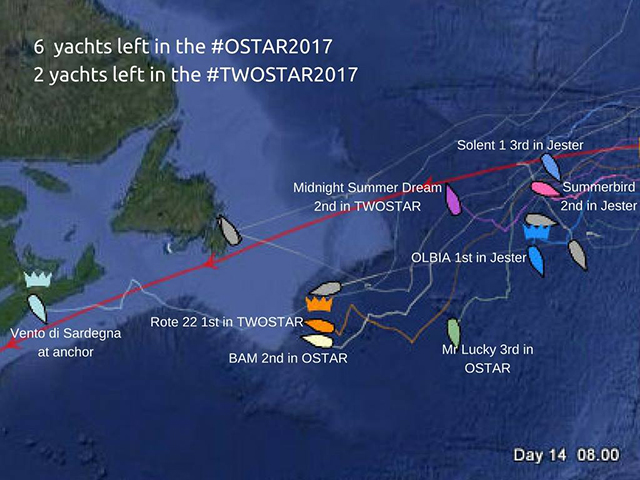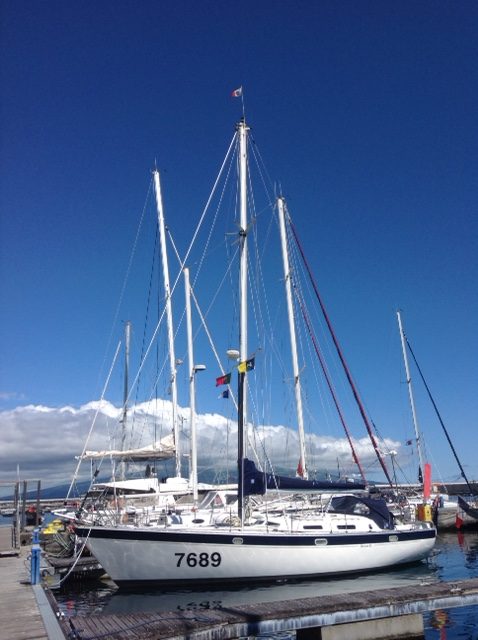 Warrior 40 - Storm Meets OSTAR Fleet
Warrior 40 - Storm Meets OSTAR Fleet
June 12, 2017, Practical Boat Owner reports: In the early hours of Friday 9 June, 60-knot winds and 15-metre seas were experienced by competitors of the OSTAR and TwoSTAR Fleet, caused by a very low depression (967 mb).
These extreme conditions caused damage to many boats with three emergency beacons (EPIRB) triggered. The Canadian coastguard in Halifax immediately reacted to the situation sending ships and air support to all the boats in distress.
Read more about this event in this Practical Boat Owner article
David Southwood, sailing Warrior 40 SY Summerbird in the OSTAR, writes:
“… You will be pleased to learn that the Hydrovane saved both Summerbird and me.”
“It held the boat just off the wind during both these nights in extremely heavy seas with very large waves breaking over the boat. In effect the Hydrovane held Summerbird ‘hoved to’ during those 36 hours.”
“Without it I would have been in distress”
From: David Southwood
Sent: June 25, 2017
To: John Curry; Sarah Curry
Subject: SUMMERBIRD
Dear John and Sarah,
As you know from previous correspondence I started the single-handed trans Atlantic yacht race OSTAR from Plymouth, England to Newport, Rhode Island on 29th May. The 21 vessel fleet followed the great circle route along 50 degrees north for nearly two weeks. I was alternating the lead in my class. On 9th June we hit a massive storm of hurricane force winds 50-70 knots and again the next night. Four boats were abandoned with skippers picked up by ships. My good friend aboard Tamarind was lucky enough to be rescued by the Queen Mary 2. Only seven of the fleet were able to continue.
By the time of the storm I had lost the staysail and had reefed in the genoa. The reefing line parted so I dropped the sail leaving me with just a main with three reefs. You will be pleased to learn that the Hydrovane saved both Summerbird and me. It held the boat just off the wind during both these nights in extremely heavy seas with very large waves breaking over the boat. In effect the Hydrovane held Summerbird “hoved to” during those 36 hours. Without it I would have been in distress.
I sought refuge and sailed over 700 nm with three reefs in the main and a storm jib primarily employing the Hydrovane until the last 250 nm when I had enough fuel to motor. I am now in Horta in the Azores effecting repairs. Well done to Hydrovane!
Best regards,
David Southwood
—
On 27 Jun 2017, at 01:01, John Curry wrote:
Hi David
It is very kind of you to share your story with us. Even in our distant location we had hourly reports of the rescues underway and boats lost.
I am often asked what to do with the Hydrovane in a storm. My answer always has been to make it part of the equation as each boat reacts differently – a handkerchief of a sail, preferably a staysail or stormsail, and the Hydrovane.
With your reefed main what did you do with the main rudder and the Hydrovane? I know what I would do with only a staysail but not when without it. Certainly, be trying this and that………………… and anxious to get in my bunk.
How long was the storm when winds were over 50 knots? I see that 50 to 70 knots produce seas of 30 to 50 feet. I have never experienced anything like that – only a 32 hour blow of 40+ knots and seas of 25 feet says the Beaufort scale. That was violent enough.
May we include your email on our website? You would be in good company.
Thanks again
John
John E. Curry, CA/CPA
—
From: David Southwood
Sent: June 27, 2017
To: John Curry
Cc: Sarah Curry; Will Curry
Subject: Re: SUMMERBIRD
Hi John and Sarah,
The storm lasted 36 hours but as Summerbird went through the eye there was a lull between the two nights of 60-70 knots. The vane was lowered to about 45 degrees and was set 90 degrees to the boat’s heading. The ratio control was on the extreme left setting. The Hydrovane rudder was not lashed but the boat’s rudder was lashed midships.
Please use my information on your website.
With best regards,
David
Contact

